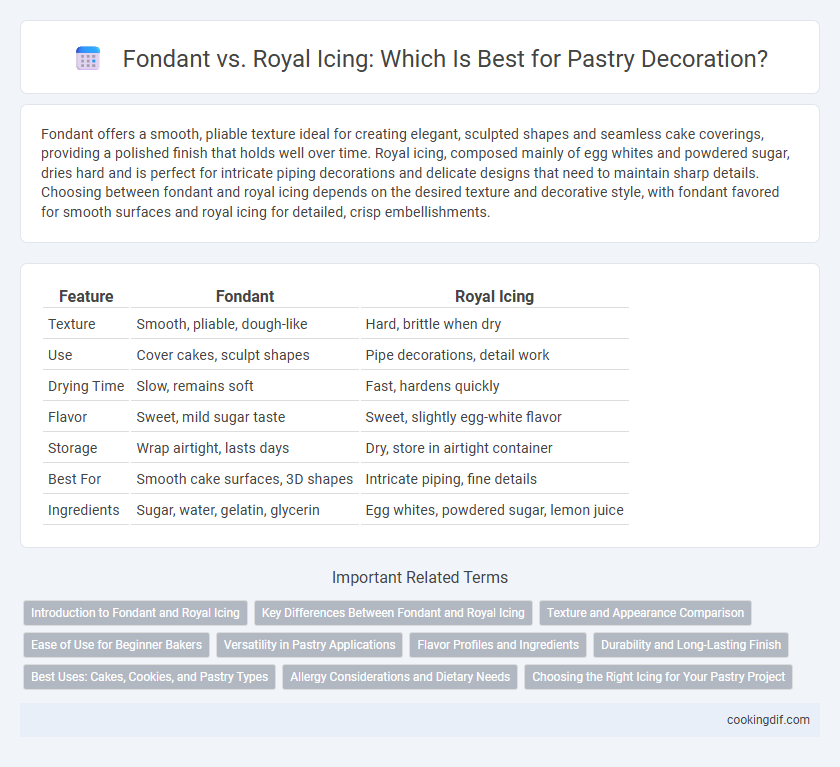Fondant offers a smooth, pliable texture ideal for creating elegant, sculpted shapes and seamless cake coverings, providing a polished finish that holds well over time. Royal icing, composed mainly of egg whites and powdered sugar, dries hard and is perfect for intricate piping decorations and delicate designs that need to maintain sharp details. Choosing between fondant and royal icing depends on the desired texture and decorative style, with fondant favored for smooth surfaces and royal icing for detailed, crisp embellishments.
Table of Comparison
| Feature | Fondant | Royal Icing |
|---|---|---|
| Texture | Smooth, pliable, dough-like | Hard, brittle when dry |
| Use | Cover cakes, sculpt shapes | Pipe decorations, detail work |
| Drying Time | Slow, remains soft | Fast, hardens quickly |
| Flavor | Sweet, mild sugar taste | Sweet, slightly egg-white flavor |
| Storage | Wrap airtight, lasts days | Dry, store in airtight container |
| Best For | Smooth cake surfaces, 3D shapes | Intricate piping, fine details |
| Ingredients | Sugar, water, gelatin, glycerin | Egg whites, powdered sugar, lemon juice |
Introduction to Fondant and Royal Icing
Fondant is a smooth, pliable icing made from sugar, water, and gelatin, ideal for creating sleek, polished cake surfaces and intricate edible decorations. Royal icing, composed primarily of egg whites and powdered sugar, dries hard and is perfect for detailed piping and delicate decorative accents. Both icings serve distinct purposes in pastry decoration, with fondant providing a flawless canvas and royal icing offering precise, textured embellishments.
Key Differences Between Fondant and Royal Icing
Fondant provides a smooth, pliable texture ideal for covering cakes with a flawless finish, while royal icing dries hard and is preferred for intricate piping and detailed decorations. Fondant remains soft and moldable after application, allowing three-dimensional shaped designs, whereas royal icing hardens completely, creating a durable, crisp surface. The sugar content and drying properties distinguish fondant's malleability from royal icing's firm, brittle consistency, impacting their uses in pastry decoration.
Texture and Appearance Comparison
Fondant offers a smooth, pliable texture that creates a sleek, polished finish ideal for covering cakes with a satin-like appearance. Royal icing dries to a hard, glossy surface perfect for intricate, detailed designs and delicate piping work. While fondant provides a soft, moldable canvas, royal icing excels in crisp, textured decorations that stand out visually.
Ease of Use for Beginner Bakers
Fondant offers a smooth, pliable texture that beginner bakers find easy to roll and shape, making it ideal for creating polished, professional-looking decorations without advanced skills. Royal icing requires precise consistency control and piping techniques, which can be challenging for novices but allows for intricate designs once mastered. For ease of use, fondant provides a more forgiving medium, while royal icing demands practice to achieve clean, detailed results.
Versatility in Pastry Applications
Fondant offers unmatched versatility in pastry decoration, allowing for smooth, seamless finishes and intricate sculpting suitable for cakes, cupcakes, and molded shapes. Royal icing excels in detailed piping, creating delicate lacework, borders, and floral designs that harden quickly for structural stability. Both are essential tools for decorators, with fondant providing pliability and royal icing delivering precision in various pastry applications.
Flavor Profiles and Ingredients
Fondant is made primarily from sugar, water, and gelatin or glycerin, offering a smooth, sweet, and mildly vanilla-flavored texture ideal for creating polished cake surfaces. Royal icing, composed of powdered sugar, egg whites, and lemon juice, provides a crisp, sweet, and slightly tangy flavor with a firm texture perfect for detailed piping and intricate designs. The choice between fondant and royal icing depends on desired flavor intensity and decorative technique, with fondant delivering a softer sweetness and royal icing yielding a more pronounced sugary tang.
Durability and Long-Lasting Finish
Fondant offers a smooth, pliable surface that maintains its shape well over time, making it ideal for creating intricate, long-lasting designs on pastries. Royal icing dries hard and provides a durable, crisp finish that resists moisture and holds detailed piping work securely. For pastries requiring extended display or transport, royal icing's toughness outperforms fondant's softer texture, ensuring decorations stay intact longer.
Best Uses: Cakes, Cookies, and Pastry Types
Fondant offers a smooth, pliable texture ideal for covering cakes and creating intricate decorative shapes, making it perfect for wedding cakes and sculpted pastries. Royal icing dries hard, making it best suited for detailed cookie decoration and delicate piping work on gingerbread houses or smaller pastries. Cakes requiring a sleek finish benefit from fondant, while cookies and pastries needing precise, firm designs excel with royal icing.
Allergy Considerations and Dietary Needs
Fondant, typically made from sugar, water, and gelatin, can pose allergy risks for individuals with gelatin sensitivity or strict vegetarian diets. Royal icing contains egg whites, making it unsuitable for those with egg allergies or vegan lifestyles. Selecting between fondant and royal icing requires careful attention to ingredient compositions to accommodate dietary restrictions and allergen concerns in pastry decoration.
Choosing the Right Icing for Your Pastry Project
Fondant provides a smooth, pliable surface ideal for creating intricate designs and a polished finish, making it perfect for elegant, sculpted desserts. Royal icing dries hard and glossy, excelling in detailed piping work and sturdy decorations that hold their shape well, especially for gingerbread houses or delicate border accents. Selecting fondant or royal icing depends on the pastry project's need for texture, detail precision, and the desired longevity of the decoration.
Fondant vs Royal Icing for pastry decoration Infographic

 cookingdif.com
cookingdif.com